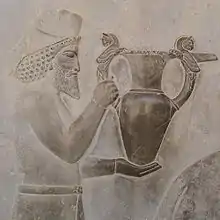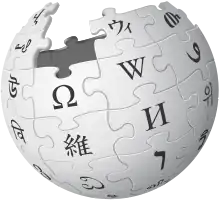𐎠𐎼𐎷𐎡𐎴𐎹
Old Persian

An early 5th century BC relief of an Armenian tribute bearer. This relief is from the eastern stairs leading to the Apadana at Persepolis.
Etymology
Masculine gender adjective formed from 𐎠𐎼𐎷𐎡𐎴 (a-r-mi-i-n /Armina/, “Armenia”) + -𐎡𐎹 (-i-y /-yaʰ/, adjectival suffix), used as a substantive.
Noun
𐎠𐎼𐎷𐎡𐎴𐎹 (Arminiya)
- an Armenian
- late 6th century BC, Darius the Great, Behistun Inscription, Column 2, lines 29-31
- ...θātiy Dārayavauš xšāyaθiya Dādaršiš nāma Arminiya manā badaka avam adam frāišayam Arminam avaθāšaiy aθaham paraidiy kāra hya hamiçiva manā naiy gaubataiy avam jadiy...
- King Darius says: An Armenian named Dādarši, my servant, I sent into Armenia, and I said unto him: 'Go, smite that host which is in revolt and does not acknowledge me.'
- late 6th century BC, Darius the Great, Behistun Inscription, Column 3, lines 76-83
- ...θātiy Dārayavauš xšāyaθiya yātā adam Pārsaiy u[t]ā Mādaiy āham patiy duvitîyam Bābiruviyā hamiçiyā abava hacāma I martiya Arxa nāma Arminiya Halditahya puça hauv udapatatā Bābirauv Dubāla nāmā dahyāuš hacā avadaša hauv kārahyā avaθā adurujiya adam Nabukudracara amiy hya Nabunaitahya puça pasāva kāra Bābiruviya hacāma hamiçiya abava abiy avam Arxam ašiyava Bābirum hauv agarbāyatā hauv xšāyaθiya abava Bābirauv...
- King Darius says: While I was in Persia and in Media, the Babylonians revolted from me a second time. A certain man named Arakha, an Armenian, son of Haldita, rebelled in Babylon. At a place called Dubāla, he lied unto the people, saying: 'I am Nebuchadnezzar, the son of Nabonidus.' Then did the Babylonian people revolt from me and they went over to that Arakha. He seized Babylon, he became king in Babylon.
- late 6th century BC, Darius the Great, Behistun Inscription, Column 2, lines 29-31
- Armenia
Related terms
- 𐎠𐎼𐎷𐎡𐎴 (a-r-mi-i-n /Armina/)
Descendants
- → Elamite:
- Achaemenid Elamite: 𒄯𒌋𒌋𒉡𒅀 (har-man-nu-ia /Harmanuya/), 𒄯𒈪𒉡 (har-mi-nu /Harminu/), 𒄯𒈪𒉡𒅀 (har-mi-nu-ia /Harminuya/)[1]
See also
 Armenian people on Wikipedia.Wikipedia
Armenian people on Wikipedia.Wikipedia  Behistun Inscription on Wikipedia.Wikipedia
Behistun Inscription on Wikipedia.Wikipedia
References
- Tavernier, Jan (2007) Iranica in the Achaemenid Period (ca. 550–330 B.C.): Lexicon of Old Iranian Proper Names and Loanwords, Attested in Non-Iranian Texts, Peeters Publishers, →ISBN, page 93
This article is issued from Wiktionary. The text is licensed under Creative Commons - Attribution - Sharealike. Additional terms may apply for the media files.